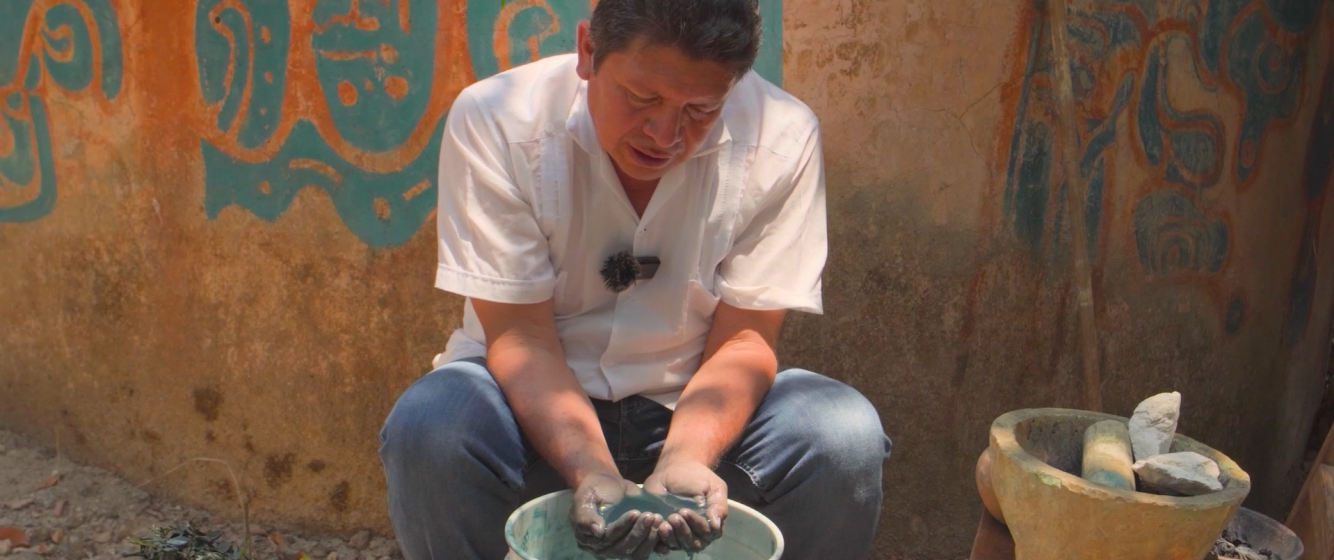
Mexican teacher and artisan Luis May Ku cupping water steeped in choja or indigo leaves. Cloth is submerged in this liquid when dyeing and initially looks clear/transparent until the solution is exposed to oxygen, turning a rich blue.
Credit: Luis May Ku, Mexico (2025)
"Indigo Dialogues" Roundtable
Organised for the Africa-Asia 3 Conference-Festival in Dakar, Senegal, Indigo Dialogues brought together researchers, craft dyers, and artists to discuss indigo as a framework for dialogue between Africa, Asia, and Latin America and explore the possibility of a shared, trans-disciplinary syllabus and teaching schedule across HAB partner universities.
Abstract:
Traditions and itineraries of indigo are windows into the transnational circulation of ideas, skills, tools, and techniques across different geographical landscapes and frames of value. As sites of cultural transmission and meaning-making, community-based indigo production and dyeing embody generationally passed-on livelihood practices.
Attending to the diverse human, nature, and technology articulations in the different sites of production of indigo, roundtable participants shared their observations, interviews and experience with indigo in conversation with traditional knowledge custodians through short videos and presentations along the following sites of knowledge and meaning:
- the ecological (land, water, climate) and economic (class & gender) context of cultivation of the plant;
- the extraction of the dye, the infrastructure of built structures, tools, techniques, recipes, linguistic markers, and skills involved;
- its distribution locally, nationally and internationally (the different channels and stakeholders)
- myriad uses (both value and meaning – identity, power, status, religious, health & well-being, art, craft, fashion, etc.)
- Literary production – stories, myths, songs, proverbs associated with the plant and dye.
Videos shown during the roundtable included the recently rediscovered Maya Blue pigment in Yucatan, Mexico, spatial drone mapping of abandoned 19th-century indigo dyeing pits in India, the harvesting of wild gara indigo leaves in Burkina Faso and Ghana, interviews with female indigo dyers in Senegal, the journey of reconnecting indigenous weaving practices with the "forgotten blue" of Taiwan, and the folk history of the Sakon Nakhon region in Thailand's custodianship of indigo. These videos will be made available on the HAB website at a later date at the discretion of each of the participants.
Chair:
- Jody Benjamin, Howard University, Washington D.C., USA
Convenor:
- Aarti Kawlra, Humanities Across Borders (HAB), International Institute for Asian Studies (IIAS), Netherlands
Participants:
- Eric Tamatey Lawer, University of Ghana, Ghana
- Mohomodou Houssouba, University of Basel, Switzerland
- Ludovic Kibora, Institut des Sciences des Sociétés (INSS-CNRST), Burkina Faso
- Hsiao-Chi Chu, Taipei National University of the Arts (TNUA), Taiwan and Leiden University, Netherlands
- Aminata Sall, Université Gaston Berger (UGB), Saint-Louis, Senegal
- Idrissa "Badri" Dembele, Independent Indigo Dyer, Bamako, Mali
- Karthik Prema Rajakumar, Independent Researcher, Chennai, India
- Luis May Ku, Teacher and Ceramicist, Yucatán, Mexico
- Pimnara (Baitong) Chanorn, Mahidol University, Thailand
Université Cheikh Anta Diop de Dakar (UCAD)
LNB-29B, Nouveau Batiment (LNB)
Dakar
Senegal
Email:
[email protected]